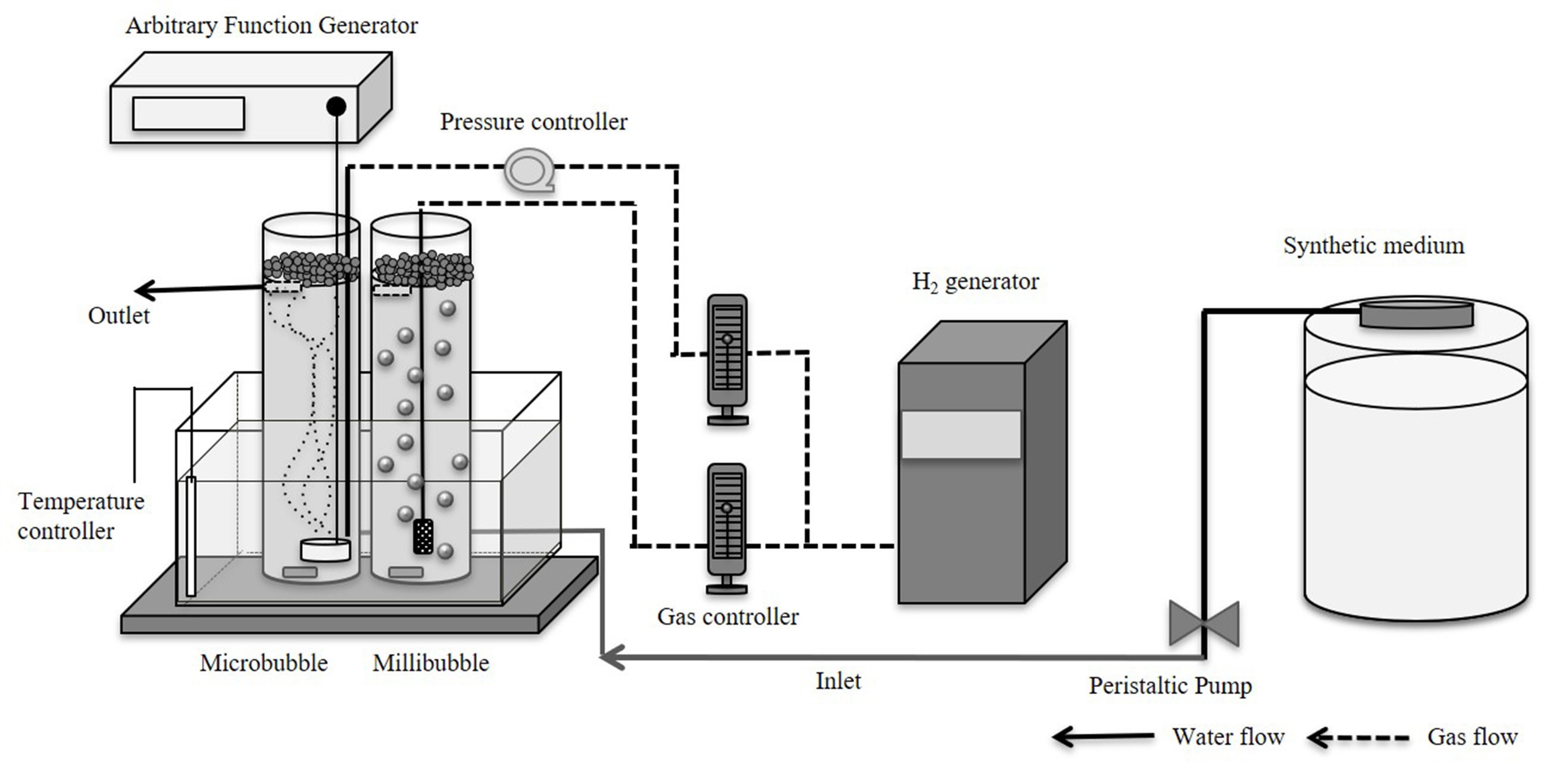Microbubble Application to Enhance Hydrogenotrophic Denitrification for Groundwater Treatment DOI: 10.32526/ennrj.18.2.2020.15
Main Article Content
Abstract
The physicochemical and biological characteristics of milli-microbubbles were compared to evaluate their performance on hydrogenotrophic denitrification (HD) for groundwater treatment in remote areas. The hydrogen supply was controlled at 1.14 L/d with 40 mgN/L of NO3-N. The microbial community structure in two bubble reactors was investigated by high throughput sequencing. Microbubbles enhanced biodegradation in the HD system, providing a maximum nitrogen removal efficiency of 99%. Approximately 50% of total hydrogen was utilized for biological nitrate removal with the highest hydrogen effectiveness achieved at 1.21 g N/g H2. In contrast, millibubbles achieved less than 10% efficiency and 9.9% of total hydrogen was consumed for biological nitrogen removal. Thauera spp., Hydrogenophaga spp. and Rhodocyclaceae of Proteobacteria phylum were the dominant bacteria in the microbubble reactor, whereas Methyloversatilis spp. was dominant in the millibubble reactor, in which a relatively low amount of hydrogen (0.6 mg/L) was dissolved. The differences can be attributed to the higher hydrogen transfer efficiency (45×10-3 s-1) and lower rising velocity (0.31 mm/s) of the microbubbles system than the millibubbles system (2×10-3 s-1 and 480 mm/s). The micro-hydrogen bubble technology affords increased hydrogen effectiveness, reduced energy consumption, and modified system design. Therefore, it is more appropriate for enhancing HD.
Article Details
Published articles are under the copyright of the Environment and Natural Resources Journal effective when the article is accepted for publication thus granting Environment and Natural Resources Journal all rights for the work so that both parties may be protected from the consequences of unauthorized use. Partially or totally publication of an article elsewhere is possible only after the consent from the editors.
References
2. Chen DHW, Ji B, Li W, Yu J. A high-throughput sequencing study of bacterial communities in an autohydrogenotrophic denitrifying bio-ceramsite reactor. Process Biochemistry 2015;50(11):1904-10.
3. Chen DXD, Dawen C, Sha W, Xiaona H, Wenru L, Dianhai Y. Performance and microbial ecology of a nitritation sequencing batch reactor treating high-strength ammonia wastewater. Scientific Reports 2016;6(1):1-8.
4. Cruz AJG, Silva AS, Araujo MLGC, Giordano RC, Hokka CO. Estimation of the volumetric oxygen tranfer coefficient (KLa) from the gas balance and using a neural network technique. Brazilian Journal of Chemical Engineering 1999;16(2):179-83.
5. Eamrat R, Yuya T, Tatsuru T, Willawan K, Yasuhiro T, Futaba K. Optimization of hydrogenotrophic denitrification behavior using continuous and intermittent hydrogen gas supply. Journal of Water and Environment Technology 2017; 15(2):65-75.
6. Ghafari S, Masitah H, Mohamed KA. Effect of carbon dioxide and bicarbonate as inorganic carbon sources on growth and adaptation of autohydrogenotrophic denitrifying bacteria. Journal of Hazardous Materials 2009;162(2-3):1507-13.
7. Ghosh P. Coalescence of bubbles in liquid. Bubble Science, Engineering and Technology 2009;1:75-8.
8. Juretschko S, Alexander L, Angelika L, Michael W. The microbial community composition of a nitrifying-denitrifying activated sludge from an industrial sewage treatment plant analyzed by the full-cycle rRNA approach. Systematic and Applied Microbiology 2002;25(1):84-99.
9. Karanasios KA, Vasiliadou IA, Pavlou S, Vayenas DV. Hydrogenotrophic denitrification of potable water: A review. American Water Work Association 2010;180(1-3):20-37.
10. Khanitchaidecha W, Maneesha S, Kamei T, Futaba K. NH4-N removal through nitrification and hydrogenotrophic denitrification in simple attached growth reactors. Water, Air, and Soil Pollution 2012;223(7):3939-53.
11. Khatlwada NR, Takizawa S, Tran TVN, Inoue M. Groundwater contamination assessment for sustainable water supply in Kathmandu valley, Nepal. Water Science and Technology 2002;46(9):147-54.
12. Lee JW, Lee KH, Park KY, Maeng SK. Hydrogenotrophic denitrification in a packed bed reactor: Effects of hydrogen-to-water flow rate ratio. Bioresource Technology 2010; 101(11):3940-6.
13. Mansell BO, Edward DS. Hydrogenotrophic denitrification in a microporous membrane bioreactor. Water Research 2002; 36(19):4683-90.
14. Mao Y, Yu X, Tong Z. Characterization of Thauera-dominated hydrogen-oxidizing autotrophic denitrifying microbial communities by using high-throughput sequencing. Bioresource Technology 2013;128:703-10.
15. Mousavi S, Shaliza I, Mohamed KA. Effects of operational parameters on the treatment of nitrate-rich wastewater by autohydrogenotrophic denitrifying bacteria. Water and Environment Journal 2013;28(3):556-65.
16. Mustakhimov I, Marina GK, Mary EL, Ludmila C. Insights into denitrification in methylotenera mobilis from denitrification pathway and methanol metabolism mutants. Journal of Bacteriology 2013;195(10):2207-11.
17. Nuclear L. Environmental remediation and restoration technologies in nuclear decommissioning projects. Decommissioning 2012;416-47.
18. Painmanakul P, Jidapa W, Marupatch J, Gilles H. Theoretical prediction of volumetric mass transfer coefficient (KLa) for designing an aeration tank. Engineering Journal 2009; 13(3):13-28.
19. Pathak DR, Hiratsuka A, Wata I. Assessment of nitrate contamination in groundwater of a shallow aquifer in Kathmandu, Nepal. Hydrology Science Journal 2009; 329:178-83.
20. Rice EW, Baird RB, Eaton AD, Clesceri LS. Standard Methods for the Examination of Water and Wastewater. 22nd ed. New York, USA: American Water Works Association; 2012.
21. Shrimali M, Singh KP. New methods of nitrate removal from water. Environmental Pollution 2001;112(3):351-9.
22. Stenstrom MK. Measurement of Oxygen Transfer in Clean Water (ASCE/EWRI 2-06). New York, USA: American Society of Civil Engineers; 2007.
23. Sun Y, Dandan S, Xiaoli Z, Na S, Yuan T. Microbial diversity and community structure of denitrifying biological filters operated with different carbon sources. SpringerPlus 2016;5(1):1752-60.
24. Takahashi M. Zeta potential of microbubbles in aqueous solutions: electrical properties of the gas-water interface. Journal of Physical Chemistry 2005;109(46):21858-64.
25. Tirado R. Nitrate in Drinking Water in the Philippines and Thailand. Greenpeace South East Asia; 2007.
26. Vasiliadou IA, Karanasios KA, Pavlou S, Vayenas DV. Hydrogenotrophic denitrification of drinking water using packed-bed reactors. Desalination 2009;248(1-3):859-68.
27. Wang H, Qiulai H, Dan C, Li W, Zhuocheng Z. Microbial Community in a hydrogenotrophic denitrification reactor based on pyrosequencing. Applied Microbiology and Biotechnology 2015;99:10829-37.
28. World Health Organization (WHO). Guidelines for Drinking Water Quality. 4th ed. Switzerland: Publication of World Health Organization; 2011.
29. Xiao Y, Yue Z, Song W, Zhao Y. Bacterial community structure of autotrophic denitrification biocathode by 454 pyrosequencing of the 16S rRNA gene. Environmental Microbiology 2015;492-9.

